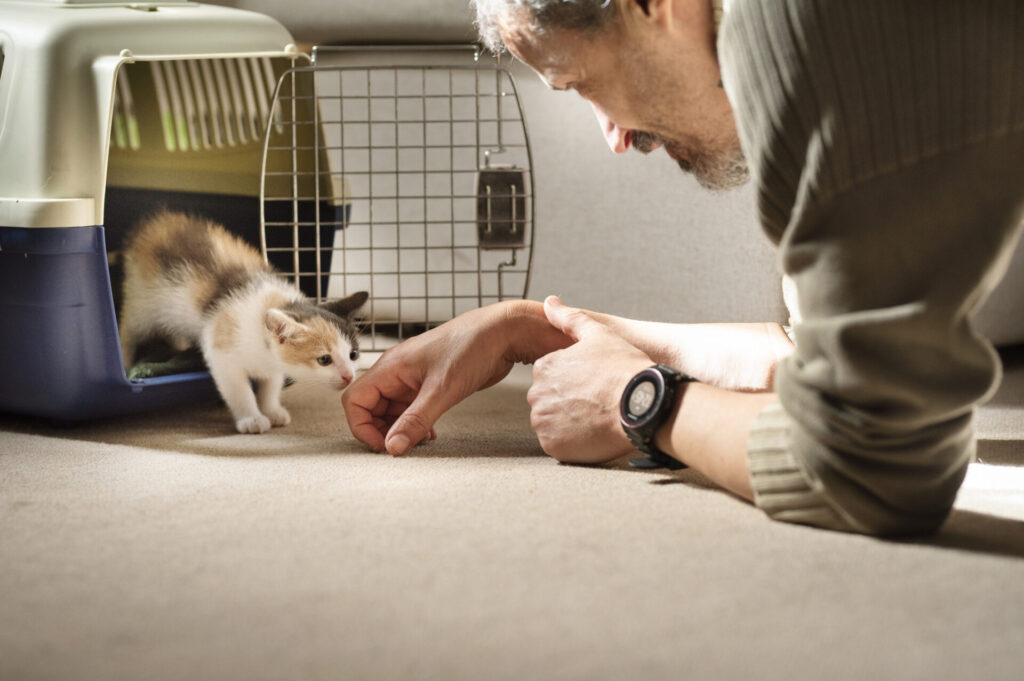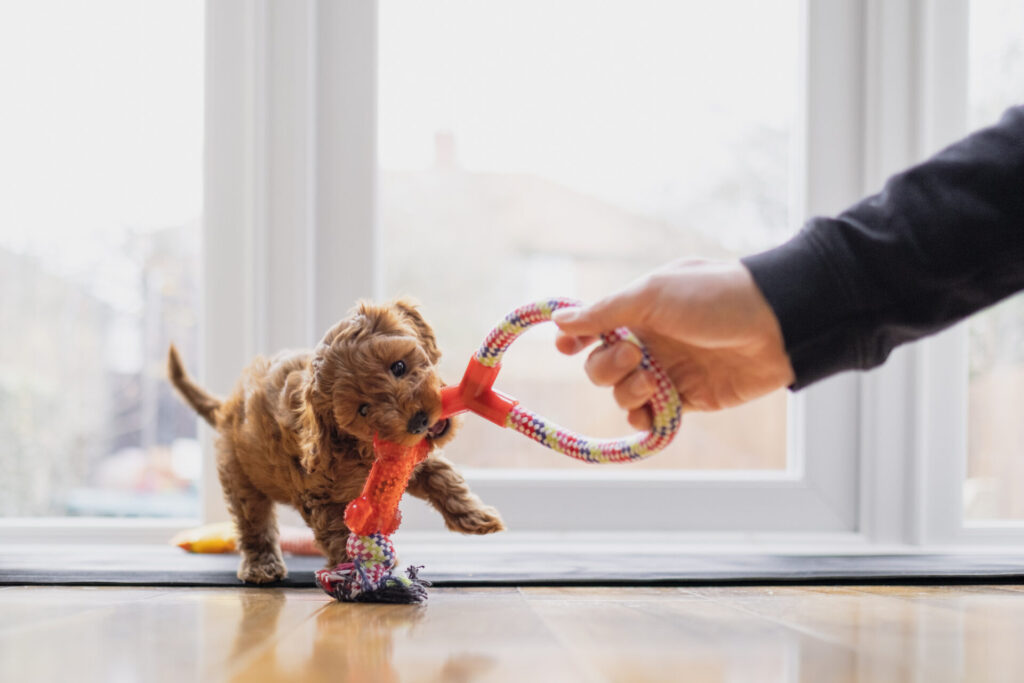Welcoming a new pet into your home is an exciting journey filled with joy and, admittedly, a few challenges. It’s the start of an incredible chapter for you and your new furry family member. With patience and proper care, your new pet will soon settle into their loving forever home.
Adopting a pet is a big decision that comes with responsibility. For a successful adoption, prepare your space, introduce your pet to your family, schedule healthcare, and establish a consistent routine. Remember, your pet looks to you for guidance and reassurance.
If you are considering adopting and have just opened your home to a new cat or dog, here’s what to expect and how to create a smooth transition for your new companion.
Preparing your home
Before your new cat or dog sets a paw inside their new home, ensure their new environment is safe and welcoming. Start by pet-proofing your home. If you have any house plants, check to see if they are poisonous to animals, and remove any that may be toxic. Secure loose wires or any small items that could be chewed on or swallowed.
Once your house is safe and pet-proofed, it’s time to stock up on supplies. Try to purchase the same food your new pet has been eating at their shelter or last home. If you wish to change the food, gradually mix a little of the new food to help your pet adjust. Make sure food and water bowls are in an accessible place for your pet and are an appropriate size. Treat puzzles or slow-feeding bowls are a great way to help new pets slow down when eating and get in some enrichment. You’ll also want to consider where you place litter boxes or pee pads. For cats, put litter boxes in easy-to-access spots that offer quiet and privacy.
When welcoming a new pet, creating a safe space for them in your home is important. The space could be a crate, a specific room, or a cozy corner with bedding and toys. Creating a safe and cozy area will help your new pet ease into their new environment. Bring a bed, blanket or toy your new pet had at their last home into your space. A familiar scent will help your pet get comfortable and adjust to their new home.
With cats, it can help to start them off in one room and then allow them to explore your home as they settle in. Gradually letting them explore your home will give them a sense of security and a place to retreat if they become overwhelmed or anxious. It also helps with potty training and setting up boundaries. Make sure to introduce them to the area, allowing them to explore at their own pace and providing plenty of positive reinforcement when they spend time there.
Introductions to the family and other pets

Getting your pet settled and introduced to your family and other pets can take time. Consider taking some time off work or working from home to help get your new furry friend established in your home and used to its new surroundings and family.
When introducing your new pet to family members, take a gradual approach. For the first few days, do your best to supervise your pet and family members. Introducing your pet to kids is best done when your pet and kids are calm and comfortable. Talk to your children about staying quiet when first interacting with their new pet and instruct them not to yell or run. Once your pet is comfortable, let each person spend time with the pet one-on-one to build trust.
If you have other pets, introduce them slowly to your new furry friend. Pay attention to each animal’s behaviour and watch for any aggression towards each other. You want your pets meeting each other to be a positive experience, so reward your pets with treats and have toys on hand to redirect their attention if they get too excited. Remember that pets will need time to get comfortable with each other.
Monitoring health and behavior
Schedule a visit to the vet for a general health check-up and vaccinations. Ask the previous owner or the shelter or breeder about any known health issues your pet or its parents may have. Having an idea of any potential health concerns can help you know what to keep an eye out for. Breeders, kennels and shelters typically include vaccination and vet records in your new pet’s paperwork. If you’re not given any information, ask for it.
Stress or illness may happen as your pet transitions into your home and lifestyle, so be sure to watch for any warning signs. Encourage good behaviour from day one and avoid reinforcing poor habits. Watch for any odd behaviour that might indicate health issues. Even well-behaved pets may have a few bad habits or act differently due to stress and change. Immediate intervention can prevent minor concerns from turning into significant problems.
Establishing routines

Routines are comforting to pets. Even housebroken adult dogs will still need time and training to get used to their new home and your routines. Establish clear feeding times, stick to a schedule for exercise and play, and start grooming habits early. Consistency in these areas will help your pet understand what to expect and significantly aid their adaptation to their new home. Start your training and establish routines when you bring your new pet home.
Build your dog’s confidence to be home alone by leaving the house for a few minutes before returning. It will help them get used to people coming in and out and spending time alone. Then, gradually increase the time you are gone, allowing your dog to get used to being alone for longer periods. Be sure to reward good behaviour when you return.
If you plan on crate training your new dog, start right away. Make sure the crate is comfortable, and take your time introducing your dog to the space. Start by leaving your pet in the crate for short periods while you leave the house to help them get used to it. Have their favourite toy or blanket in the crate with them. You want your dog to enjoy their crate rather than see it as a punishment, so have your dog lay in there with the door open while you are home, so it feels like a safe and comfortable space for them.
Find a good vet and get pet insurance
Having a trusted veterinarian can be crucial for maintaining your pet’s health. You’ll want to look for the right veterinarian who is close to your home and has a good reputation and will want to consider the amenities they offer. Take your pet in for regular health checks and stay up to date on vaccinations.
Your vet is an expert and will help keep your pet healthy. Regular checkups with your veterinarian can help you discover any concerns early so they can stay healthy and happy for many years. Having a good relationship with your vet means knowing who to ask if you have any questions or concerns about your pet’s behaviour.
You may want to pick the right pet insurance to help manage the eligible costs of vet visits. The unexpected can happen, and insurance can help you financially when it does. Did you know if you’re a CAA Member, you can save 13.5% on pet insurance plans with Pets Plus Us*?
*CAA Members receive a preferred rate of 13.5% off effective April 15, 2024. Non-members receive a preferred rate of 9% off effective April 15, 2024.
The information herein is summarized. All Pet Insurance plans have limitations and exclusions. Specific products, features, coverage limits, rates, and discounts may vary by province, eligibility, and are subject to change. Medical Conditions that are noted, symptomatic or diagnosed prior to enrollment, or during a waiting period are pre-existing to Coverage and not eligible for reimbursement. This advertisement is an outline only, the actual policy issued Terms and Conditions will prevail.
© 2024 All rights reserved. Pets Plus Us Pet Insurance policies are underwritten by Northbridge General Insurance Corporation, distributed by PTZ Insurance Services Ltd. & Société d’Assurances Collectives (Sodaco) Inc. in Quebec. Pets Plus Us Pet Insurance is available in all provinces and territories. Pets Plus Us®, Pets Plus Us & Design and related words and logos are trademarks and the property of PTZ Insurance Services Ltd.

